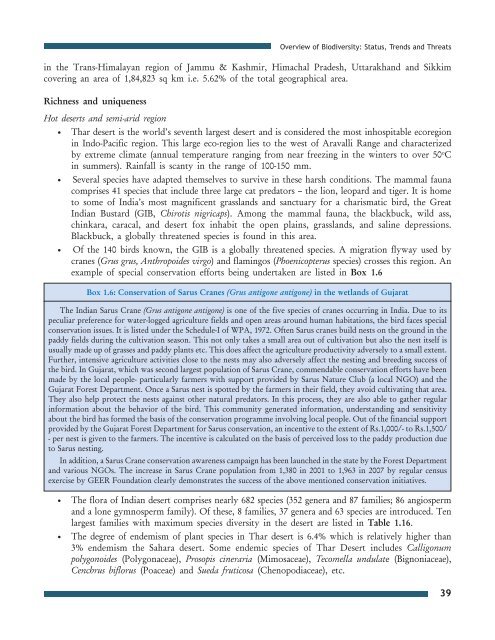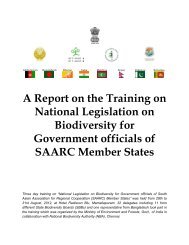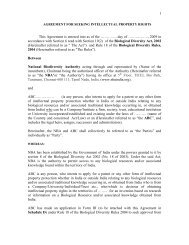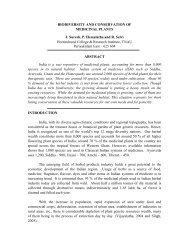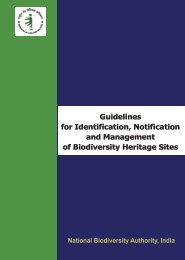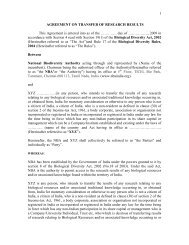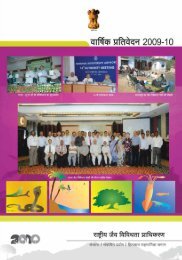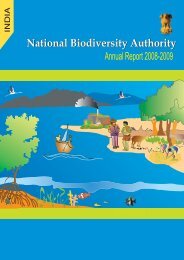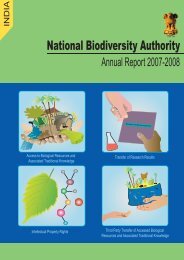Part 1 - English version (PDF) - Convention on Biological Diversity
Part 1 - English version (PDF) - Convention on Biological Diversity
Part 1 - English version (PDF) - Convention on Biological Diversity
You also want an ePaper? Increase the reach of your titles
YUMPU automatically turns print PDFs into web optimized ePapers that Google loves.
in the Trans-Himalayan regi<strong>on</strong> of Jammu & Kashmir, Himachal Pradesh, Uttarakhand and Sikkim<br />
covering an area of 1,84,823 sq km i.e. 5.62% of the total geographical area.<br />
Richness and uniqueness<br />
Overview of Biodiversity: Status, Trends and Threats<br />
Hot deserts and semi-arid regi<strong>on</strong><br />
Thar desert is the world’s seventh largest desert and is c<strong>on</strong>sidered the most inhospitable ecoregi<strong>on</strong><br />
in Indo-Pacific regi<strong>on</strong>. This large eco-regi<strong>on</strong> lies to the west of Aravalli Range and characterized<br />
by extreme climate (annual temperature ranging from near freezing in the winters to over 50 o C<br />
in summers). Rainfall is scanty in the range of 100-150 mm.<br />
Several species have adapted themselves to survive in these harsh c<strong>on</strong>diti<strong>on</strong>s. The mammal fauna<br />
comprises 41 species that include three large cat predators – the li<strong>on</strong>, leopard and tiger. It is home<br />
to some of India’s most magnificent grasslands and sanctuary for a charismatic bird, the Great<br />
Indian Bustard (GIB, Chirotis nigricaps). Am<strong>on</strong>g the mammal fauna, the blackbuck, wild ass,<br />
chinkara, caracal, and desert fox inhabit the open plains, grasslands, and saline depressi<strong>on</strong>s.<br />
Blackbuck, a globally threatened species is found in this area.<br />
Of the 140 birds known, the GIB is a globally threatened species. A migrati<strong>on</strong> flyway used by<br />
cranes (Grus grus, Anthropoides virgo) and flamingos (Phoenicopterus species) crosses this regi<strong>on</strong>. An<br />
example of special c<strong>on</strong>servati<strong>on</strong> efforts being undertaken are listed in Box 1.6<br />
Box 1.6: C<strong>on</strong>servati<strong>on</strong> of Sarus Cranes (Grus antig<strong>on</strong>e antig<strong>on</strong>e) in the wetlands of Gujarat<br />
The Indian Sarus Crane (Grus antig<strong>on</strong>e antig<strong>on</strong>e) is <strong>on</strong>e of the five species of cranes occurring in India. Due to its<br />
peculiar preference for water-logged agriculture fields and open areas around human habitati<strong>on</strong>s, the bird faces special<br />
c<strong>on</strong>servati<strong>on</strong> issues. It is listed under the Schedule-I of WPA, 1972. Often Sarus cranes build nests <strong>on</strong> the ground in the<br />
paddy fields during the cultivati<strong>on</strong> seas<strong>on</strong>. This not <strong>on</strong>ly takes a small area out of cultivati<strong>on</strong> but also the nest itself is<br />
usually made up of grasses and paddy plants etc. This does affect the agriculture productivity adversely to a small extent.<br />
Further, intensive agriculture activities close to the nests may also adversely affect the nesting and breeding success of<br />
the bird. In Gujarat, which was sec<strong>on</strong>d largest populati<strong>on</strong> of Sarus Crane, commendable c<strong>on</strong>servati<strong>on</strong> efforts have been<br />
made by the local people- particularly farmers with support provided by Sarus Nature Club (a local NGO) and the<br />
Gujarat Forest Department. Once a Sarus nest is spotted by the farmers in their field, they avoid cultivating that area.<br />
They also help protect the nests against other natural predators. In this process, they are also able to gather regular<br />
informati<strong>on</strong> about the behavior of the bird. This community generated informati<strong>on</strong>, understanding and sensitivity<br />
about the bird has formed the basis of the c<strong>on</strong>servati<strong>on</strong> programme involving local people. Out of the financial support<br />
provided by the Gujarat Forest Department for Sarus c<strong>on</strong>servati<strong>on</strong>, an incentive to the extent of Rs.1,000/- to Rs.1,500/<br />
- per nest is given to the farmers. The incentive is calculated <strong>on</strong> the basis of perceived loss to the paddy producti<strong>on</strong> due<br />
to Sarus nesting.<br />
In additi<strong>on</strong>, a Sarus Crane c<strong>on</strong>servati<strong>on</strong> awareness campaign has been launched in the state by the Forest Department<br />
and various NGOs. The increase in Sarus Crane populati<strong>on</strong> from 1,380 in 2001 to 1,963 in 2007 by regular census<br />
exercise by GEER Foundati<strong>on</strong> clearly dem<strong>on</strong>strates the success of the above menti<strong>on</strong>ed c<strong>on</strong>servati<strong>on</strong> initiatives.<br />
<br />
<br />
The flora of Indian desert comprises nearly 682 species (352 genera and 87 families; 86 angiosperm<br />
and a l<strong>on</strong>e gymnosperm family). Of these, 8 families, 37 genera and 63 species are introduced. Ten<br />
largest families with maximum species diversity in the desert are listed in Table 1.16.<br />
The degree of endemism of plant species in Thar desert is 6.4% which is relatively higher than<br />
3% endemism the Sahara desert. Some endemic species of Thar Desert includes Callig<strong>on</strong>um<br />
polyg<strong>on</strong>oides (Polyg<strong>on</strong>aceae), Prosopis cineraria (Mimosaceae), Tecomella undulate (Bign<strong>on</strong>iaceae),<br />
Cenchrus biflorus (Poaceae) and Sueda fruticosa (Chenopodiaceae), etc.<br />
39


